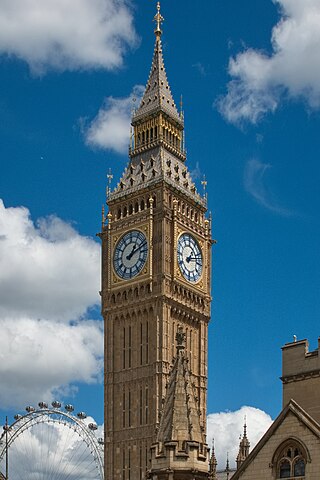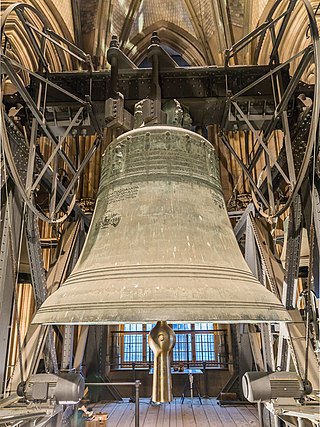
This is a compilation of functioning bells in Boston, Massachusetts , located primarily in bell towers.

This is a compilation of functioning bells in Boston, Massachusetts , located primarily in bell towers.

Change ringing is the art of ringing a set of tuned bells in a tightly controlled manner to produce precise variations in their successive striking sequences, known as "changes". This can be by method ringing in which the ringers commit to memory the rules for generating each change, or by call changes, where the ringers are instructed how to generate each change by instructions from a conductor. This creates a form of bell music which cannot be discerned as a conventional melody, but is a series of mathematical sequences. It can also be automated by machinery.

The Whitechapel Bell Foundry was a business in the London Borough of Tower Hamlets. At the time of the closure of its Whitechapel premises, it was the oldest manufacturing company in Great Britain.

Campanology is the scientific and musical study of bells. It encompasses the technology of bells—how they are founded, tuned and rung—as well as the history, methods, and traditions of bellringing as an art.
The Westminster Quarters, from its use at the Palace of Westminster, is a melody used by a set of four quarter bells to mark each quarter-hour. It is also known as the Westminster Chimes, Cambridge Quarters, or Cambridge Chimes, from its place of origin, the Church of St Mary the Great, Cambridge.

A bell is a directly struck idiophone percussion instrument. Most bells have the shape of a hollow cup that when struck vibrates in a single strong strike tone, with its sides forming an efficient resonator. The strike may be made by an internal "clapper" or "uvula", an external hammer, or—in small bells—by a small loose sphere enclosed within the body of the bell.

A church bell is a bell in a Christian church building designed to be heard outside the building. It can be a single bell, or part of a set of bells. Their main function is to call worshippers to the church for a service of worship, but are also rung on special occasions such as a wedding, or a funeral service. In certain Christian traditions, such as Catholicism and Lutheranism, church bells signify to people both inside and outside of the church that a particular part of the service has been reached. The ringing of church bells thrice a day occurs in congregations of certain Christian denominations as a call to prayer, reminding the faithful to pray the Lord's Prayer or the Angelus Domini.
A handbell is a bell designed to be rung by hand. To ring a handbell, a ringer grasps the bell by its slightly flexible handle – traditionally made of leather, but often now made of plastic – and moves the arm to make the hinged clapper strike the inside of the bell. An individual handbell can be used simply as a signal to catch people's attention or summon them together, but handbells are also often heard in tuned sets.

In the Roman Rite of the Catholic Church, Lutheranism, Methodism and Anglicanism, an altar bell is typically a small hand-held bell or set of bells. The primary reason for the use of such bells is to create a “joyful noise to the Lord” as a way to give thanks for the miracle taking place atop the altar.

A "ring of bells" is the name bell ringers give to a set of bells hung for English full circle ringing. The term "peal of bells" is often used, though peal also refers to a change ringing performance of more than about 5,000 changes.

Big Ben is the nickname for the Great Bell of the Great Clock of Westminster, and, by extension, for the clock tower itself, which stands at the north end of the Palace of Westminster in London, England. Originally known simply as the Clock Tower, it was renamed Elizabeth Tower in 2012 to mark the Diamond Jubilee of Elizabeth II. The clock is a striking clock with five bells.
Rudhall of Gloucester was a family business of bell founders in the city of Gloucester, England, who between 1684 and 1835 cast more than 5,000 bells.

Richard Phelps (c.1670–1738) was born in Avebury, Wiltshire, England. Phelps was a bellfounder, or a maker of bells, primarily for churches. He was master of the Whitechapel Bell Foundry in London from 1701 to 1738, and is best known for his large bell, Great Tom, in the steeple of St Paul's Cathedral in London, England. The foundry, in operation since at least 1570, was listed by the Guinness Book of Records as the oldest manufacturing company in Great Britain.

Petersglocke, commonly referred to as Dicker Pitter, is the largest bell in Cologne Cathedral. It was cast in 1923 by Heinrich Ulrich in Apolda and hangs in the belfry of the south tower. With a weight of approximately 24,000 kilograms (53,000 lb), a clapper weighing about 700 kilograms (1,500 lb) and a diameter of 322 centimetres, it is the second largest freely swinging ringable bell in the world, after the bell of the People's Salvation Cathedral in Bucharest, Romania.

The Church of All Saints is the Church of England parish church for the large village of Wrington, Somerset, England. There has been a church here since the 13th century, though much of the present building dates from the 15th century. Historic England have designated it a Grade I listed building.

A bell-ringer is a person who rings a bell, usually a church bell, by means of a rope or other mechanism.

Full circle ringing is a technique of ringing a tower bell such that it swings in a complete circle from mouth upwards to mouth upwards and then back again repetitively.

The Olympic Bell was commissioned and cast for the 2012 London Olympic Games, and is the largest harmonically tuned bell in the world. Cast in bronze bell metal, it is 2 metres high with a diameter of 3.34 metres, and weighs 22 long tons 18 cwt 3 qr 13 lb. The bell is now displayed in the Olympic Park.

The All Saints Cathedral Bells are heritage-listed church bells at All Saints Anglican Cathedral, Church Street, Bathurst, in the Central West region of New South Wales, Australia. They were built from 1853 to 1855 by John Warner and Sons, Crescent Foundry of London, England. They were added to the New South Wales State Heritage Register on 10 September 2004.

Evesham Bell Tower is the freestanding belfry for the town of Evesham, Worcestershire. Originally founded in 1207 by Adam Sortes, the present tower, the fourth to stand on the same site, was founded and built by Clement Lichfield, Abbot of Evesham, as the bell tower for Evesham Abbey in the 16th century. It is the only part of the abbey complex to survive wholly intact.
Campanology is the scientific and musical study of bells. It encompasses the technology of bells – how they are cast, tuned, and rung – as well as the history, methods, and traditions of bellringing as an art. Articles related to campanology include: